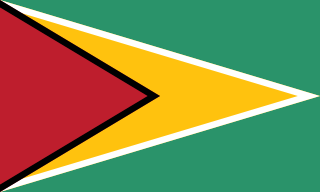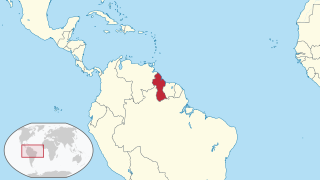
This article is about the demographic features of Guyana, including population density, ethnicity, education level, health of the populace, economic status, religious affiliations and other aspects of the population.

Lethem is a town in Guyana, located in the Upper Takutu-Upper Essequibo region. It is the regional capital of Upper Takutu-Upper Essequibo.
Indo-Guyanese or Indian-Guyanese, are people of Indian origin who are Guyanese nationals tracing their ancestry to the Indian subcontinent. They are the descendants of indentured laborers and settlers who emigrated from India beginning in 1838 during the time of the British Raj.
Afro-Guyanese people are generally descended from the enslaved people brought to Guyana from the coast of West Africa to work on sugar plantations during the era of the Atlantic slave trade. Coming from a wide array of backgrounds and enduring conditions that severely constrained their ability to preserve their respective cultural traditions contributed to the adoption of Christianity and the values of British colonists.

The Wapichan or Wapishana are an indigenous group found in the Roraima area of southern Guyana and northern Brazil.

The Guyana Defence Force (GDF) is the military of Guyana, established in 1965. It numbers about 4500 soldiers and more than 3000 resurve personal and has military bases across the nation. The Commander-in-Chief of the Defence Force is always the incumbent President of Guyana.

David Arthur Granger is a Guyanese politician and retired military officer who served as the 9th President of Guyana from May 2015 to August 2020. He served for a time as Commander of the Guyana Defence Force and subsequently as National Security Adviser from 1990 to 1992. He was Leader of the Opposition in the National Assembly of Guyana from 2012 to 2015.
Aubrey Cummings was a renowned Guyanese musician and singer, who in 1978 migrated to Barbados. He was also an artist.

Brazil–Guyana relations have traditionally been close. Brazil has provided military assistance to Guyana in the form of warfare training and logistics. Bilateral relations between the countries have recently increased, as a result of Brazil's new South-South foreign policy aimed to strengthen South American integration.
The article describes the state of race relations and racism in South America. Racism of various forms is found in every country on Earth. Racism is widely condemned throughout the world, with 170 states signatories of the International Convention on the Elimination of All Forms of Racial Discrimination by August 8, 2006. In different countries, the forms that racism takes may be different for historic, cultural, religious, economic or demographic reasons.

The following outline is provided as an overview of and topical guide to Guyana:

Guyana, officially the Co‑operative Republic of Guyana, is a country on the northern mainland of South America and the capital city is Georgetown. Guyana is bordered by the Atlantic Ocean to the north, Brazil to the south and southwest, Venezuela to the west, and Suriname to the east. With 215,000 square kilometres (83,000 sq mi), Guyana is the third-smallest sovereign state by area in mainland South America after Uruguay and Suriname; it is also the second-least populous sovereign state in South America after Suriname.
English is the official language of Guyana, which is the only South American country with English as the official language.

The following is an alphabetical list of topics related to the Co-operative Republic of Guyana.

The Takutu River Bridge is a bridge across the Takutu River, linking Lethem in Guyana to Bonfim in Brazil. It was completed in 2009 and opened on 31 July 2009. Its official inauguration was on 14 September 2009, in the presence of leaders of both countries. It cost US$5 million and was paid for by Brazil. The bridge was a project within the Initiative for the Integration of the Regional Infrastructure of South America.
Guyanese Americans are an ethnic group of Americans who can trace their ancestry back to Guyana. As of 2011, there are 208,899 Guyanese Americans currently living in the United States. The majority of Guyanese live in New York City – some 140,000 – making them the fifth-largest foreign-born population in the city.
Brazilians in Guyana consists of Brazilian nationals, mostly miners, living in Guyana as well as Guyanese people of Brazilian descent. There are currently about 10,000 Brazilians living in Guyana.

Women in Guyana are a cross-section of Guyanese society whose numbers have fluctuated with time. A country with primarily Indo-Guyanese, Afro-Guyanese and Amerindian women, Guyana has also been home to women of European or Chinese descent. The country has had a female president, Janet Jagan. Although it is part of South America, Guyana is culturally and historically aligned with the Commonwealth Caribbean and is often compared to Trinidad and Tobago.

Indigenous peoples in Guyana, or Native Guyanese, are Guyanese people who are of indigenous ancestry. They comprise approximately 9.16% of Guyana's population. Amerindians are credited with the invention of the canoe, as well as Cassava-based dishes and Guyanese pepperpot, the national dish of Guyana. Amerindian languages have also been incorporated in the lexicon of Guyanese Creole.

Pele FC is a Guyanese football club based in Georgetown, competing in the GFF Elite League, the top tier of Guyanese football. The club was founded in 1971 and is named after Brazilian football legend Pelé.











